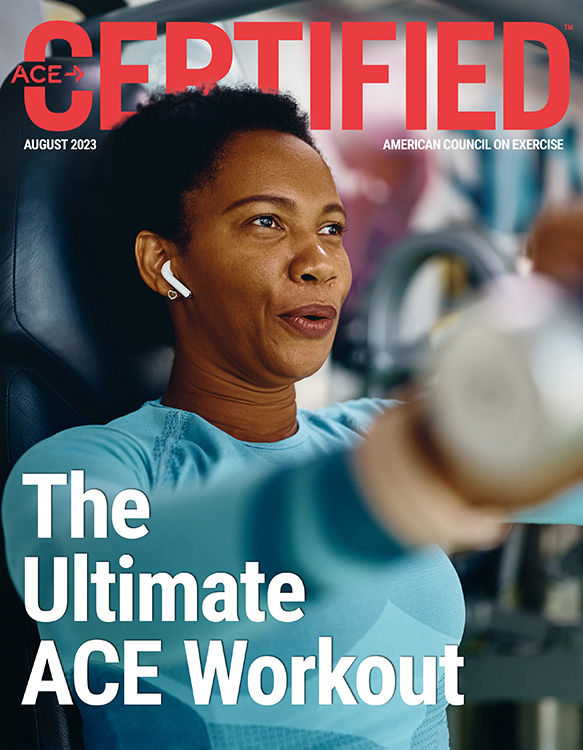
As a health and exercise professional, you’re trained to assess your clients’ fitness levels and create programs that are tailored to their unique needs. Over time, you help them gradually progress and improve their strength, endurance, flexibility, balance and coordination, while also making the workouts exciting to keep your clients coming back. And, of course, you want them to see the results they’re after.
This is one of the reasons it can be so easy for trainers to fall into the trap of making workouts grueling or even “hardcore” on some level, secretly hoping their clients are sore for a few days following their workout to convince them of its effectiveness. While some delayed onset muscle soreness (DOMS) is to be expected, it is not necessarily a good gauge to go by to determine whether a workout is effective—or, for that matter, safe. This is especially true for the core.
“Only working the abs and forgetting the foundations [of strengthening the core] are two big mistakes that are made,” argues Joy Puleo, MA, NCPT, director of education at Balanced Body. “Clients want to immediately jump right into complexity and we, as exercise professionals, often want to give them something fun. But the ‘hard’ and ‘fun’ are most advantageous when they are built on a strong foundation.”
The Body’s Foundation
The core functions as the body’s foundation. It’s made up of (give or take) 30 muscle pairs that comprise a three-dimensional box—from the neck and shoulders down to the pelvic floor muscles and glutes—and also front to back. The core is also divided into two units: the inner unit and the outer unit.
The inner unit muscles are used primarily for fine segmental stabilization of the spine (spine stabilizers). The outer unit muscles provide mobility of the spine, gross stabilization and motor control during higher-intensity exercise (spine movers).
Because the core is the body’s foundation, it is imperative that it is built solidly before other, more difficult exercises are added to the exercise program. Having clients do more difficult exercises with a weak core could set them up for injury. And even more specifically, the inner core unit must initially be the primary focus over the outer core.
“The core is essential to moving as an integrated and coordinated person in the world,” says Puleo. “We sometimes overemphasize and overwork the primary muscle group most associated with the core—the abdominals—when in fact, the abdominals, the diaphragm, the pelvic floor, the erector spinae, muscles of the hips, and some of the muscles that support and anchor to the trunk are part of a three-dimensional, well-functioning core.”
Ideally, all movement is initiated from the primary axis of the body—the core—according to Michele Olson, PhD, FACSM, senior clinical professor of sports science at Huntingdon College. “These muscles support you and power you through all the movements, such as standing, walking, picking up objects, balancing, reaching up to the top shelf in your kitchen, etc. They are also vital to helping you maintain your balance.”
Olson explains that “these muscles are truly the base muscles in your body. Foundational exercises prepare and prime your core for more challenging and advanced exercises. It’s like a pyramid. It starts with a strong base. If the base is weak or nonexistent, you cannot add heavy bricks on top of it—the heavy bricks being more complex and advanced movements.”
Building a foundation also allows your clients to build a strong mind-body connection. “By starting with foundational exercises, you start from a place where the client can self-assess and become more aware of their own sensations and abilities,” says Puleo. “And you, the exercise professional, can also determine baseline ability and chart a path toward client goals. In addition, for the body, you literally strengthen the important connections intrinsically.”
Puleo offers an example related to the core. “The pelvic floor and breathing are connected, so just taking a moment to focus on breathing helps to restore and support these interrelated components of the core,” explains Puleo. “Very often, we use the breath to bear down, or clients will hold their breath. In both cases, the pelvic floor–breath connections will be altered in ways that will not maximize potential and may ultimately lead to pelvic floor issues. In teaching the foundations, you are not taking a step back. You are, in fact, building toward training potential.”
Safe, Effective Core Progressions
It’s important to note that there is no single, perfect progressive sequence to use with your clients. As a health and exercise professional, it is your responsibility to assess each client’s abilities, skills and fitness level. This includes acknowledging previous and current injuries and pain levels in various parts of their body.
One starting point to consider, says Gina Iovenitti, MS, exercise physiologist and growth operations manager for Carda Health, especially for clients with chronic low-back pain, is The McGill Big 3, named after Stuart McGill, PhD, the researcher who developed the sequence. It includes the McGill curl-up, the side bridge/plank (modified, with knees bent and bottom knee on the floor) and the bird-dog.
And if the bird-dog exercise is initially too challenging for a client, “a good introduction to [it] is the dead bug exercise,” suggests Iovenitti.
Olson’s recommendations for a foundational core sequence include:
- Body-weight squats or chair squats
- Body-weight stationary lunges
- Wall push-ups or push-ups from knees
- Rowing motion (squeezing the shoulder blades together)
- Basic face-down yoga plank from knees
- Face down Superman extensions
- Standing calf raises
During each exercise, instruct your clients to practice proper posture and technique, and to engage their core by keeping their belly button pulled in toward their spine.
“When [your client] can do all of the above for about two sets of 15 reps without undue fatigue or muscle and balance shakiness, you can start adding weight, such as dumbbells, to squats, lunges, rows and calf raises,” advises Olson. You can also encourage your clients to try performing planks and push-ups from their feet instead of their knees.
If your clients are just not “feeling” how to engage their core muscles during any of the exercises, Puleo suggests simply helping to bring awareness to their core with one of the most basic positions: standing.
Urge your clients to try this: “Find a tall, comfortable posture and lean forward and back until you feel the core. When tipping forward into gravity, literally the core lights up to support you. And as your weight shifts back onto your heels, you will feel the muscles of the back body light up to support you. This brings awareness of internal support and lift of the core—front and back—when standing tall,” says Puleo.
Two of Puleo’s favorite supine foundational exercises are marching to toe taps and ab curl. “And on all fours, my two favorites are cat-cow, for spinal mobility through the core, and bird-dog,” says Puleo.
It is imperative to pay attention to your clients’ form and encourage them to communicate to you how each exercise feels. “This is the beauty of foundational and progressive exercise training,” says Puleo. “You keep adding a skill and when the skill can be met with movement competency, then you add another. When the skill breaks down, you know you have exceeded a client’s physical proficiency and ability and [it’s time to] back up to build up.”
Puleo uses the bird-dog exercise as an example. “From bird-dog, progress to plank kneeling. From plank kneeling, add lifting one arm at a time or adding triceps press, then progress to full plank—and so it goes.”
One often-forgotten area of the core is the pelvic floor. “Pelvic floor exercises, a.k.a. Kegels, are a great foundational exercise for both men and women,” adds Olson.
And while it can be uncomfortable to discuss the pelvic floor, simply explaining that it is the bottom of the core box can help clients understand how it plays into core conditioning. Once clients understand how to contract the pelvic floor muscles, they can then bring this skill into other exercises, such as planks and squats. Of note, being able to fully relax the pelvic floor is as important as strengthening it, so be sure to include this in any pelvic floor exercises.
When working on core progressions, keep in mind the big picture and what your clients are trying to achieve. The core is the body’s foundation, and it is from this that other skills will be drawn. This is why you must start with very basic exercises and thoughtfully work up from there.
“Physical skill proficiency and adaptability are part of training progressive skills. And training progressive skills helps to teach and train neuromotor connections. Through these connections, we can build on ability, strength and flexibility,” concludes Puleo.
Effectively activating the muscles of the core optimizes force production and transfer through the trunk to the extremities, which enhances control of integrated movements and improves the ability to tolerate loading forces. Optimizing the function of the core muscles protects the spine from potential injury, improves balance and coordination, and dynamic postural strength and control. In other words, it is important to promote proximal stability through appropriate activation of the core muscles before progressing to more distal segments of the body.
Many newcomers to a fitness facility will want to jump right into resistance training with machines or free weights, but it’s essential that they understand the importance of building adequate stability and mobility before adding external resistance—and core strength is a vital component of that. Explain to your clients that core training is the first step, and that you’ll be systematically progressing their workouts so that they can pursue their health and fitness goals safely and effectively.
Expand Your Knowledge
Understand and apply the principles of stability and rotary power into your training design with information by industry innovator Peter Twist. Create a center for movement and force transfer by developing the core using whole body, closed-kinetic chain stability and rotary power. Regulate balance among your clients and foster dynamic performance by helping to stabilize their core, fostering powerful arms and legs.
Understanding how to train midline control (core and glutes) is essential for any exercise professional. But what exactly does that entail? This course explores why, how and when to train midline control with a simple evaluation tool that helps you identify deficiencies to improve outcomes. Whether you’re training an athlete, sedentary individual or post rehab client, you’ll be equipped with a set of progressions and regressions to enhance timing, sequencing and rhythm in multiple planes of motion.





 by
by 




